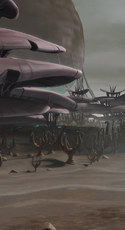| | |
A purple planet.
- "A planet can be described as a single organism, a living creature with a skeleton of stone and a heart of molten rock. The species that inhabit a planet, plant and animal alike, from microbe to megalossus, are the planet-creature's organs, internal symbionts, and parasites."
- ―Vergere to Jacen Solo, as an analogy to a Sh'rip Sh'pa
A planet, often called a world, was a celestial body that was in orbit around a star, was neither a binary star nor a moon, and had cleared out the area around its orbit as it formed by causing all other smaller bodies in its orbit to accrete with it. As a consequence, it would not share its orbital region with any other bodies of significant size, except for moons or those collected later under its gravitational influence.
Overview
Two types of planets existed in the galaxy: gas giants and terrestrial rocky worlds. Moons orbiting gas giants and other rocky worlds were usually not considered as planets, even though they could be larger or more populated than other planets, although Zonama Sekot was considered to be both at different time periods due to its unique mobile nature.

Some planets, like Balnab, were still going through stages of organic development
Depending on the tilt of the planet's axis, planets also had varied seasons with ranging temperatures and weather, affecting the habitability of one. Planets were extremely varied in terms of environmental conditions and landscape, ranging from completely oceanic, such as Manaan, Dac, and Kamino, to thick arboreal rainforests, such as Kashyyyk and Felucia. Some planets, such as Hoth, were completely frozen, while other planets, such as Nelvaan, were experiencing an ice age. Some planets, like Geonosis, Korriban, and Tatooine, were completely barren and desolate, covered in little more than rock and sand; while others, such as Coruscant and Taris, became an ecumenopolis, in which the entire planetary surface was covered by one gigantic city. Many planets, like Dantooine, Naboo, Alderaan, and Corellia, contained a mix of landscapes, with various continents, oceans, and mountains.
Most life-bearing planets had primarily nitrogen and oxygen-based Type I atmospheres; though some, such as Dorin, Gand, and Skako, had unique atmospheres to which their native life forms had adapted. Gas giants, planets made up of primarily gaseous layers, were rarely inhabited, though they were sometimes used for resource collection (such as the Tibanna gas operations on Bespin).
Some planets have a large collection of space debris orbiting it, referred to as "rings" due to resembling the jewelry of the same name. They can range from being thin to being expansive.
Sentience
Sentience among planets, while rare, was not unheard of. Yuuzhan'tar, Zonama Sekot and D'vouran were three notable examples of sentient planets.

